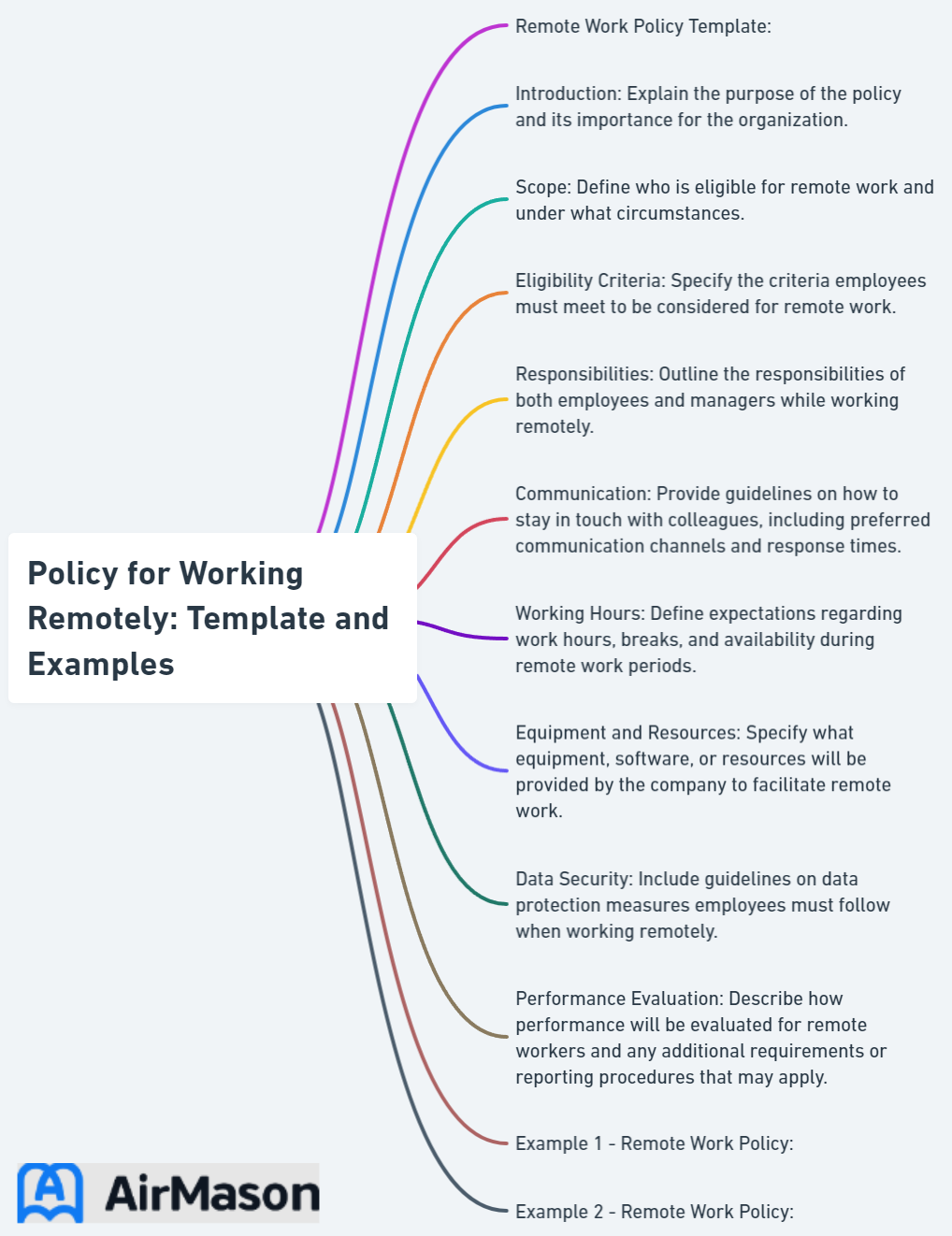
In today’s rapidly evolving work landscape, remote work has become a crucial aspect of many organizations. Implementing a well-structured policy for working remotely is essential to ensure consistency, fairness, and productivity among remote employees. In this blog post, we will delve into the nuances of creating a comprehensive policy for working remotely, its key components, and how it can benefit your organization.
Key Takeaways
- Remote work policy provides a framework for outlining expectations and processes for remote workforce.
- Policy should include eligibility criteria, communication practices, equipment provisions and data security measures.
- Organizations can promote occupational safety & employee engagement through home office setup guidelines, virtual team building activities & professional development opportunities.
Flexible Working Policy
Our company’s commitment to fostering a dynamic and inclusive work environment is encapsulated in our robust Flexible Working Policy. Embracing the evolving landscape of work, we recognize the importance of providing our employees with the flexibility they need to achieve a healthy work-life balance. Our Flexible Working Policy is designed to accommodate diverse needs, allowing individuals to tailor their work schedules to optimize productivity while ensuring a harmonious integration of professional and personal commitments. By championing a Flexible Working Policy, we aim to empower our workforce, enhance job satisfaction, and cultivate a culture that values individual contributions within the framework of a supportive and adaptable work structure.
Defining a Remote Work Policy
A remote work policy acts as a guiding framework, outlining the parameters, expectations, and processes for remote employees. A well-defined policy aids organizations in managing their remote workforce effectively, ensuring consistency in expectations and responsibilities. This policy typically includes elements such as:
- Eligibility criteria
- Communication practices
- Work schedules
- Equipment provisions
- Data security measures

Purpose of a Remote Work Policy
A remote work policy’s primary function is to offer a systematic method for managing remote employees, guaranteeing them equal opportunities and access to remote work arrangements. This policy plays a crucial role in promoting fairness in the workplace by setting clear guidelines and expectations for remote work.
It helps maintain consistency and transparency, ensuring that remote employees are treated equitably and are supported in their work environment, in compliance with the Fair Labor Standards Act.
Components of a Remote Work Policy
The components of a remote work policy include:
- Eligibility criteria based on job suitability and employee performance
- Expectations and guidelines for remote employees such as communication practices, work schedules, and performance monitoring
- Provisions for equipment and technical support
Additionally, data security and privacy measures should be outlined to safeguard sensitive information and ensure compliance with company policies.
Establishing Eligibility Criteria for Remote Work

Establishing eligibility criteria for remote work is a crucial part of crafting an efficient remote work policy. This typically involves evaluating job suitability and employee performance to identify which roles and individuals can effectively work remotely.
Setting clear eligibility criteria is crucial as it promotes fairness and transparency in the remote work arrangement, guaranteeing equal opportunities for all employees to access remote work.
Job Suitability
Job suitability involves evaluating which roles can be effectively executed remotely. This evaluation process takes into account factors such as:
- Communication skills
- Adaptability
- Self-discipline
- Software skills
It is important to consider these aspects to ensure that remote work arrangements, including remote work agreements and the remote work agreement, are effective and beneficial for both the employee and the organization.
Determining job suitability assists in forming a more productive remote work environment, boosting productivity and employee satisfaction.
Employee Performance
Criteria for employee performance hold a substantial role in establishing remote work eligibility. Factors such as tenure, productivity, and communication skills can be considered when evaluating an employee’s performance and suitability for remote work. Evaluating these criteria allows organizations to allocate remote work arrangements to employees who have proven their capability to sustain productivity and communicate effectively in a remote environment.
Setting Expectations and Guidelines for Remote Employees
Setting clear expectations and guidelines for remote employees is integral to guaranteeing a successful remote work setup. These guidelines help remote employees understand their responsibilities and the level of communication expected from them, enabling effective collaboration and optimum productivity.
With clear definition of these expectations, organizations can cultivate a positive work environment that makes remote employees feel supported and engaged, enhancing job satisfaction and employee retention.
Communication Practices
Effective communication stands as the bedrock of successful remote work. It is essential to establish clear communication practices to ensure seamless collaboration and prevent misunderstandings among remote employees. This may involve:
- Setting expectations for availability and responsiveness
- Using suitable communication tools
- Conducting regular virtual meetings to maintain a sense of connection and camaraderie among team members.
Encouraging open and transparent communication aids organizations in building a supportive remote work environment where employees feel connected and valued.
Work Schedules and Availability
Setting work schedules and availability expectations for remote employees is key to preserving productivity and accountability. This can be achieved by:
- Setting clear expectations regarding work hours, responsiveness, and the use of communication tools
- Ensuring that remote employees are aware of any meal and rest breaks mandated by state law
- Establishing a procedure for requesting overtime
Organizations can establish a structured remote work environment that boosts productivity and employee satisfaction by defining work schedules and availability for employees working remotely.
Performance Monitoring
Performance monitoring is crucial for tracking the progress and performance of remote employees. It allows organizations to:
- Identify any potential issues or impediments that may hinder their remote employees from achieving their objectives
- Regular check-ins with supervisors
- Track progress on tasks
- Provide feedback
These practices can help ensure that remote employees are meeting their goals and objectives.
Through effective performance monitoring, organizations can tackle any issues and assist remote employees in realizing their full potential.
Addressing Equipment and Technical Support Needs

Addressing equipment and technical support needs for remote employees is necessary to ensure a smooth remote work experience. Providing the necessary hardware, software, and technical support can help remote employees maintain productivity and effectively carry out their job duties. Additionally, it is crucial to have a clear policy in place for the provision of company-owned equipment and reimbursements for work-related expenses.
Company-Owned Equipment
Providing company-owned equipment to remote employees ensures a consistent work environment and helps maintain productivity. Companies typically supply remote employees with essential work equipment such as laptops, monitors, keyboards, and mice. Providing company-owned equipment allows organizations to bolster security, boost productivity, and attain cost efficiencies.
Reimbursements and Stipends
Reimbursements and stipends can be offered to remote employees to cover work-related expenses such as internet connection fees, phone service costs, and other necessary resources. Offering financial support for these expenses enables organizations to guarantee that remote employees have the necessary tools and resources to perform their job duties effectively.
Technical Support Services
Technical support services play a crucial role in assisting remote employees with any technical issues or difficulties they may encounter while working remotely. By offering these services, organizations can help remote employees quickly resolve technical problems and maintain productivity.
Having a clear policy for the provision of technical support services is vital, as well as ensuring remote employees know the steps to follow when they encounter technical difficulties.
Ensuring Data Security and Privacy in Remote Work
Remote work settings give rise to significant concerns regarding data security and privacy, given that remote employees frequently access sensitive company data from home networks, potentially less secure than on-site networks. To ensure data security and privacy, organizations should implement data protection measures, maintain device security, and ensure compliance with company policies.
Data Protection Measures
Implementing data protection measures is essential to safeguard sensitive information and maintain the privacy of remote employees. These measures may include the use of a virtual private network, strong passwords, multi-factor authentication, and regular security awareness training.
Organizations can safeguard their data and reduce the risk of security breaches by adopting these practices.
Device Security
Maintaining device security is crucial to prevent unauthorized access to company data and to ensure the privacy of remote employees. Remote employees should be encouraged to use company-owned devices with up-to-date security measures, such as encryption and anti-virus software.
Furthermore, remote employees should receive training on best practices for securing their devices and protecting sensitive information.
Compliance with Company Policies

Remote employees must comply with company policies to ensure data security and privacy. This includes adhering to established communication practices, utilizing secure networks and devices, and maintaining the confidentiality of sensitive information.
Enforcing compliance with company policies enables organizations to lessen the risk of data breaches and protect the privacy of remote employees.
Promoting Occupational Safety and Health for Remote Workers
Occupational safety and health are critical aspects to consider in remote work settings, as remote employees may face unique challenges and risks while working from their home offices. Organizations should provide home office setup guidelines and encourage remote employees to report any incidents or injuries that may occur in their work environment.
Promoting occupational safety and health allows organizations to support their remote employees’ well-being and guarantees a safe, productive work environment.
Home Office Setup Guidelines
Providing home office setup guidelines can help remote employees create a safe and productive work environment. These guidelines may include recommendations for ergonomic practices, such as proper chair and desk height, lighting, and maintaining a clean and organized workspace.
Adherence to these guidelines can help remote employees reduce the risk of potential health issues and sustain their productivity while working from home.
Reporting Incidents and Injuries
Encouraging remote employees to report incidents and injuries is essential for addressing any safety concerns and providing support. Organizations should establish a clear process for reporting incidents and injuries, and ensure that remote employees are aware of the steps to take when they encounter any safety issues in their home office.
Promoting a culture of safety and open communication allows organizations to safeguard the well-being of their remote workforce and lessen potential risks.
Adapting Company Culture and Employee Engagement in Remote Work
Adjusting company culture and employee engagement for remote work poses a challenge given that remote employees may feel detached from their colleagues and the organization. To foster a sense of connection and camaraderie among remote employees, organizations can provide virtual team building activities and professional development opportunities.
Virtual Team Building Activities
Virtual team building activities can help maintain a sense of connection and camaraderie among remote employees, even when they are physically apart. Some examples of virtual team building activities include:
- Virtual happy hours
- Online scavenger hunts
- Virtual game nights
- Virtual team lunches
These activities can help foster a positive and collaborative remote work environment.
Participation in these activities allows remote employees to foster relationships, strengthen teamwork, and boost morale, cumulatively contributing to a positive remote work environment.
Professional Development Opportunities

Offering professional development opportunities to remote employees can support their growth and career advancement. Organizations can provide access to:
- Webinars
- Online courses
- Virtual conferences
- Mentorship programs
These opportunities can help remote employees, including a remote employee, learn new skills and stay up-to-date with industry trends while embracing remote working.
Investing in the professional growth of remote employees enables organizations to cultivate a culture of continuous learning and development, leading to increased employee satisfaction and retention.
Summary
In conclusion, creating a comprehensive remote work policy is essential for ensuring the success of remote work arrangements. By defining eligibility criteria, setting expectations and guidelines, addressing equipment and technical support needs, ensuring data security and privacy, promoting occupational safety and health, and adapting company culture and employee engagement, organizations can establish a supportive remote work environment that benefits both the employees and the organization as a whole. Embrace the future of work by implementing a well-structured remote work policy and watch your organization thrive.
Frequently Asked Questions
What is the company policy for remote employees?
The company policy for remote employees requires them to adhere to all the conditions in the Employee Handbook and maintain compliance with other company policies. Furthermore, employees can choose from fully remote work, hybrid remote work, or flexible working remote policies based on their own needs and preferences.
What is an example of a WFH policy?
An example of a WFH policy is one that allows employees to work from home if their job duties permit it, and provides them with guidelines regarding technology and equipment responsibilities. Employees must also have access to a reliable internet connection and should contact the IT department for assistance in the event of technical or equipment issues.
How can organizations ensure effective communication among remote employees?
Organizations should establish clear communication practices, use appropriate communication tools, and hold regular virtual meetings to ensure effective communication among remote employees.
What measures can be taken to address equipment and technical support needs for remote employees?
Providing company-owned equipment, offering reimbursements and stipends, and ensuring access to technical support services are measures that can help address the needs of remote employees when it comes to equipment and technical support.
How can data security and privacy be ensured in remote work settings?
Data security and privacy can be ensured in remote work settings by implementing data protection measures, maintaining device security, and adhering to company policies.